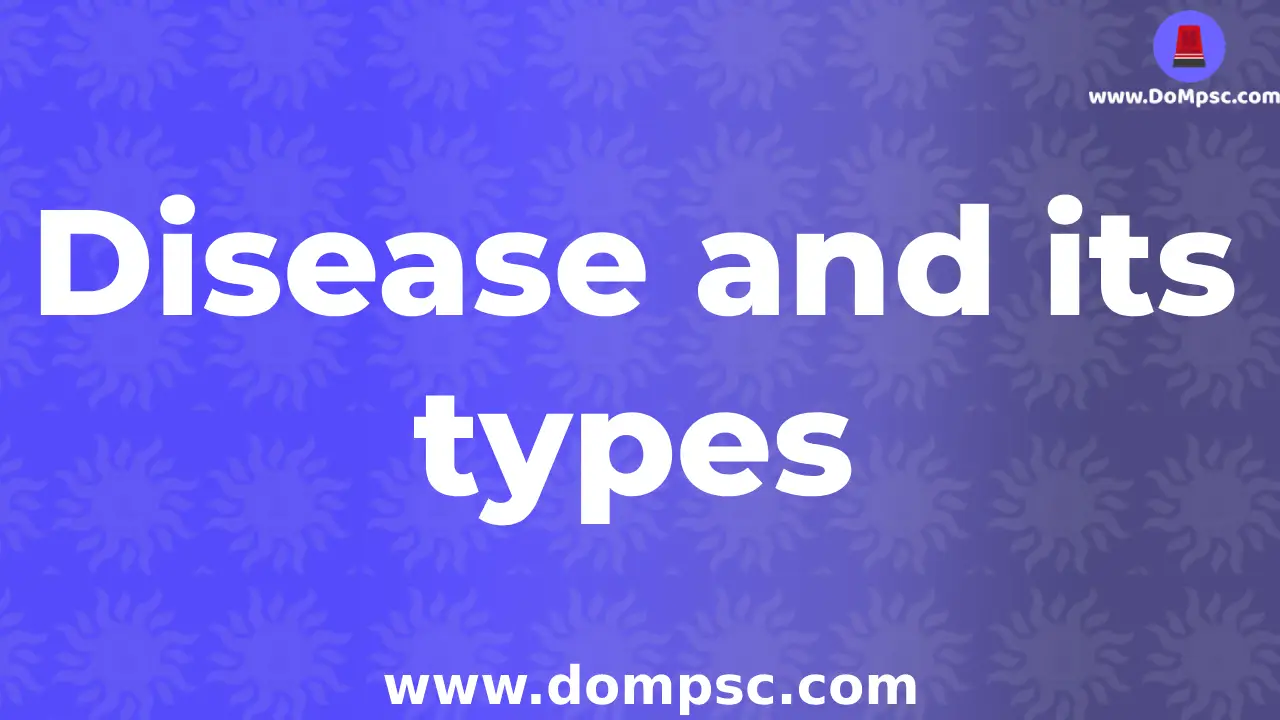MPSC disease and its types(रोग व रोगाचे प्रकार)-MPSC Biology science notes

✪ Download pdf Works Properly on chrome Browser ✪
disease and its types(रोग व रोगाचे प्रकार)
Table Of Contain-Mpsc disease and its types(रोग व रोगाचे प्रकार)
Intro of disease and its types

By Shubham Vyawahare
0-May-2025
➤ Mental health is not only depends on physical body as also on a social and metal situation of a person.
➤ Abnormal Behavior of a body in any condition is a disease.
➤ Diseases can be overcome by Overcoming the Factors for what they happened.
➤ Human have all three diseases.
➤ Nutrients are compounds in foods essential to Overcome with diseases.
➤ Human immunity power is the most important factor for a diseases.
✪ Diseases According to time ✪
Acute Diseases
➤ Diseases with short duration, rapid onset, and obvious symptoms
➤ Either person Recover Fast or die.
➤ Eg- Ebola,Corolla,Swine Flue
➤ Illness is usually caused by a virus or infection, but it can also be caused by injuries caused by falls or traffic accidents
➤ the misuse of drugs or medications.
Chronic Diseases
➤ Chronic diseases refer to human health conditions or diseases whose impact persists or persists for a long time, or diseases that come over time
➤Chronic diseases are usually caused by unhealthy behaviors, which increase the risk of disease-malnutrition, insufficient physical activity, excessive drinking or smoking. Social, emotional, environmental and genetic factors also play a role
➤ Chronic conditions are slower to develop.
➤may progress over time, and may have any number of warning signs or no signs at all.
➤Example:Alzheimer’s disease,Arthritis,Chronic obstructive pulmonary disease (COPD),Depression,Diabetes,Heart disease,High blood pressure,High cholesterol,Obesity,Osteoporosis,stroke.
✪ Diseases According To Spread ✪
Endemic Disease
➤ Local comes from the Greek word en, which means demos, which means people.
➤ENDEMIC is something that belongs to a specific nation or country.
➤This disease outbreak in particular area.
➤ So sometimes it is know with the name of area.like Spain flue.
➤ a disease that is present permanently in a region or population.
➤ Malaria is another infectious disease that is endemic to Africa.
➤Varicella, more commonly known as chickenpox in the UK.
➤ Example:Chagas Disease,Malaria,African Sleeping Sickness
Epidemic
➤Epidemics are derived from the Greek epi or above, while demos refers to people, a term used to describe the situation where a disease quickly spreads to a large number of people in a given population in a short period of time. .
➤ The term epidemic is not only used for infectious diseases. It can also be used in any situation that leads to increased social health risks.
➤ Epidemics can follow predictable patterns, and these trends are often used to monitor, predict and control the spread of infection..
➤Dengue fever is endemic in some parts of Africa, Central and South America and the Caribbean. ➤ Examples:Chikungunya,Cholera,Crimean-Congo haemorrhagic fever,Ebola virus disease,Hendra virus infection,Influenza (pandemic, seasonal, zoonotic,Lassa fever,Marburg virus disease
Pandemic
➤The pandemic is derived from the Greek word pan, which means everyone, and demos means human. It is a term used to describe the rapid spread of an infectious disease on several continents or worldwide..
➤ An easy way to understand the difference between an epidemic and an epidemic is to remember the "P" in an epidemic, which means that an epidemic has a passport. A pandemic is an epidemic that is spreading..
➤ A pandemic is an epidemic, spread over many countries or continents.
✪Stages of a Pandemic ✪
- Stage 1-The virus is visible in animals but has not yet shown infection in humans.
- Stage 2-A known animal virus has caused human infection
- Stage 3-Dispersed or isolated incidence of diseases or small groups of diseases in humans; possible cases of human-to-human transmission, but did not lead to community-level outbreaks
- Stage 4-The speed of transmission between people leads to a community outbreak
- Stage 5-The spread of the disease from person to person is obvious in more than one country
- Stage 6-Compared to Stage 5, there has been a community-level outbreak in at least one other country/region.
✪ Diseases According To Reason ✪
Infections
➤ An infection occurs when another organism enters your body and causes disease.
➤ You can get an infection in many different ways, such as directly from an infected person, through contaminated food or water, or even through insect bites.
➤Types : Viral Infection,Bacterial Infections,Fungal Infections
➤Example:malaria,toxoplasmosis,trichomoniasis,giardiasis,tapeworm infection,roundworm infection,pubic and head lice,scabies,leishmaniasis,river blindness.
Communicable:
➤ Infectious diseases are methods of spreading from one person to another in a variety of ways, including: contact with blood and body fluids; breathing airborne viruses; or being bitten by insects.
➤ Example:Ebola,Influenza,Mumps,Norovirus,Pertussis,Tuberculosis,Coronavirus.
Contagious
➤ Infectious diseases are a subcategory of transmissible diseases, which can be spread to others through accidental contact with the body of a sick person, or with their secretions or objects in contact with their contacts, or through air routes..
➤ Infectious diseases that spread from person to person are considered contagious. Some infections are spread from animals or insects to humans, but not from other people.
➤ Example:COVID-19,Norovirus (“Stomach Flu”),Influenza,Meningitis,Hand, Foot and Mouth Disease (HFMD),Pertussis,Sexually Transmitted Infections (STIs)
✪Non-Infectious✪
➤ Non-communicable diseases (NCD) are diseases that cannot be directly transmitted from one person to another
➤ This type of diseases increases in a body itself.
➤ Some Diseases are long time diseases.
➤ Non-communicable diseases (NCD), also known as chronic diseases, have a long course and are the result of a combination of genetic, physiological, environmental and behavioral factors
➤ People of all age groups, regions and countries are affected by NCDs..
➤ These diseases are driven by forces that include rapid unplanned urbanization, globalization of unhealthy lifestyles and population ageing.
➤ An unhealthy diet and lack of physical exercise may lead to increased blood pressure, increased blood sugar, increased blood lipids and obesity..
➤ Examples: Cancer,TB,Atherosclerosis,color Blindness,Haemophilia
✪Diseases Due To Microorganism✪
Bacteria
➤ Bacteria are the small microorganism present in a human body.
➤ they are bigger in size than virus.
➤ Unicellular microorganism.
➤ No Nucleus Found in a bacteria Body.
➤Bacterial Cell has a proper Body structure including body wall,body organs.
➤They are useful as well as harmful.
➤About 4 billion years ago, bacteria were thought to be the first organisms to appear on earth.
➤There are billions of bacteria in the human intestine. They help digest food, make vitamins and perform other important functions.
➤ Spherical: Bacteria shaped like a ball are called cocci, and a single bacterium is a coccus. Examples include the streptococcus group, responsible for “strep throat.”
➤ Rod-shaped: These are known as bacilli (singular bacillus). Some rod-shaped bacteria are curved. These are known as vibrio. Examples of rod-shaped bacteria include Bacillus anthracis (B. anthracis), or anthrax.
➤ Spiral: These are known as spirilla (singular spirillus). If their coil is very tight they are known as spirochetes. Leptospirosis, Lyme disease, and syphilis are caused by bacteria of this shape
➤ Bacterial Diseases:Infectious disease,Cholera,Leprosy,Tuberculosis,Plague,Syphilis,Anthrax.
Viruses
➤ an infective agent that typically consists of a nucleic acid molecule in a protein coat, is too small to be seen by light microscopy, and is able to multiply only within the living cells of a host..
➤Viruses are small parasites that cannot reproduce on their own.
➤The virus is named based on its genetic structure to facilitate the development of diagnostic tests, vaccines and drugs.
➤They Are non cellular in nature.
➤ They are very small as compare with bacteria.
➤ they have either DNA or RNA in a body.Simultaneously DNA or RNA not present ➤ They never Generate there Food.
➤ The entire infectious virus particle (called virion) is composed of a shell of nucleic acid and protein..
➤ The simplest virus contains only enough RNA or DNA to encode four proteins.
➤ Example:Hepatitis A,Hepatitis B,Human papillomavirus (HPV,Influenza,Japanese encephalitis (inflammation of the brain,Measles, mumps, and rubella,Polio,Rabies,Smallpox,Chickenpox.
Fungus
➤ Fungus are found with a cell wall and cell structure.
➤ Their Wall consist of a chitin sugar.
➤These organisms are classified as a kingdom,.
➤Fungus are useful as well as harmful in nature.
➤member of the group of eukaryotic organisms that includes microorganisms such as yeasts and molds, as well as the more familiar mushrooms.
➤Fungi are usually divided into four parts: chytrids (chytrids), zygote (bread mold), ascomycetes (yeast and cyst fungi) and basidiomycetes (club fungi).
➤ about 144,000 known species of organisms of the kingdom Fungi.
➤ Fungi have been used for the production of antibiotics.
➤ Fungus Diseases:Aspergillosis,Blastomycosis,Candidiasis,Candida auris,Coccidioidomycosis,neoformans Infection,Fungal Eye Infections.
Protozoa
➤ Protozoa (also protozoa, plural protozoa) is an informal term for a group of free-living or parasitic unicellular eukaryotes that feed on organic matter (such as other microorganisms or organic tissues and debris)..
➤They are unicellular In nature.
➤ They are found in kingdom protista.
➤ They come in many different shapes and sizes, from the amoeba of the amoeba to the paramecium with fixed shapes and complex structures.
➤ They live in a variety of humid habitats, including freshwater, marine environments and soil.
➤ These are divided into four major groups. (1) Amoeboid protozoans or sarcodines. (2) Flagellated protozoans or zooflagellates. (3) Ciliated protozoans or ciliates. (4) Sporozoans.
➤ They are found in kingdom protista.
➤ They are found in kingdom protista.
➤Diseases Due to Protozoa:African Sleeping Sickness, amoebic dysentery, and malaria.
Worms
➤ Worms are elongated invertebrates. The most famous is An, a member of the Annelida gate.
➤ Worms Diseases-Ascariasis,Filariasis.
Others Blogs Related to MPSC Biology Notes
➤Biology Exam Pattern
➤Blood Circulation System
➤Blood Groups And Its Diseases
➤Balanced Diet And Nutrients
➤Classification Of Animals
➤Classification OF Plants
➤Cell
➤Tissue
➤Coordination In Human
➤Digestive System
➤Diseases And Disease Types
➤Excretory System
➤Respiratory System
➤Reproductive System
➤Skeletal System
Read All MPSC blogs
- ➤केंद्र सरकारने खाजगी क्लासेस साठी नवी नियमावली लागू केली आहे |GUIDELINES FOR REGULATION OF COACHING CENTER in marathi
- ➤MPSC Data leak: पेपर न फुटल्याचा दावा MPSC आयोगाने स्पष्टपणे केला आहे
- ➤MPSC hall ticket data leaked before 6 days of exam
- ➤MPSC Data leak: टेलेग्राम वर अचानक ९० हजार परीक्षार्थींचे प्रवेशपत्र झाले लिक
- ➤मराठी भाषेला अभिजात दर्जा मिळायला हवाच , अभिजात दर्जा नेमका कसा मिळतो ?
MPSC Books pdf



